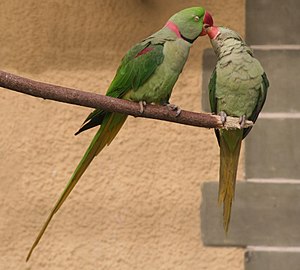Alexander Parakeet
| Alexander Parakeet | ||||||||||||
|---|---|---|---|---|---|---|---|---|---|---|---|---|

Alexander Parakeet ( Psittacula eupatria ) |
||||||||||||
| Systematics | ||||||||||||
|
||||||||||||
| Scientific name | ||||||||||||
| Psittacula eupatria | ||||||||||||
| ( Linnaeus , 1766) |
The Alexandrine Parakeet ( Psittacula eupatria ), often Alexandrine parakeet called (as opposed to little Alexandrine Parakeet , the Rose-ringed Parakeet ) is in Asia spread parrot species from the genus of Parakeets . In Germany there are two populations that can be traced back to captive animals, but are not yet established neozoa .
distribution
The natural range of the Great Alexander Parakeet stretches from Afghanistan and Pakistan to India , Burma and Thailand to Laos , Cambodia and Vietnam . He also colonized Sri Lanka and the Andamans .
Smaller populations can also be found in Germany as neozoa , for example in Wiesbaden / Mainz , Cologne or Bonn. In 2018, more than 168 breeding pairs or at least 750 individuals were counted for Germany.
External features
At 48 to 62 cm, the great Alexander parakeet is considerably larger than the other noble parakeets . It has predominantly green plumage.
It has a black ribbon around its neck and a pink ribbon at the back. There is a brownish-red stain on the shoulders. The tail feathers are blue-green and end in yellow tips. The red beak is striking. The eyes are pale yellow, the feet gray-green. The female is colored like the male, but has no collar. Color mutants are also known.
behavior
The great Alexander Parakeet lives in forests and cultivated landscapes , where it roams in swarms looking for grain , nuts , seeds and fruits .
The animals lay two to four eggs in the often self-made breeding caves. The female breeds alone and is fed by the male. The young hatch after 20 to 25 days and are fed by both parents. They leave the nest when they are around six weeks old.
Subspecies
The great Alexander Parakeet occurs in several subspecies.
In rare cases, there are hybrids with the ring-necked parakeet .
swell
- ↑ Braun, Michael u. a .: Current development of the breeding population of the great Alexander parakeet Psittacula eupatria in Germany . Vogelwarte Volume 56, Issue 4, 2018: 383-385.
- ↑ Color variants of the Alexander Parakeet
- ↑ Leonardo Ancillotto, Diederik Strubbe, Mattia Menchetti, Emiliano Mori: An overlooked invader? Ecological niche, invasion success and range dynamics of the Alexandrine parakeet in the invaded range . In: Biological Invasions . 18, No. 2, 2015, ISSN 1573-1464 , pp. 1-13. doi : 10.1007 / s10530-015-1032-y .
Web links
- Psittacula eupatria in the endangered Red List species the IUCN 2008. Posted by: BirdLife International, 2008. Accessed on December 18 of 2008.
- Videos, photos and sound recordings of Psittacula eupatria in the Internet Bird Collection
- Feathers of the Alexander Parakeet
